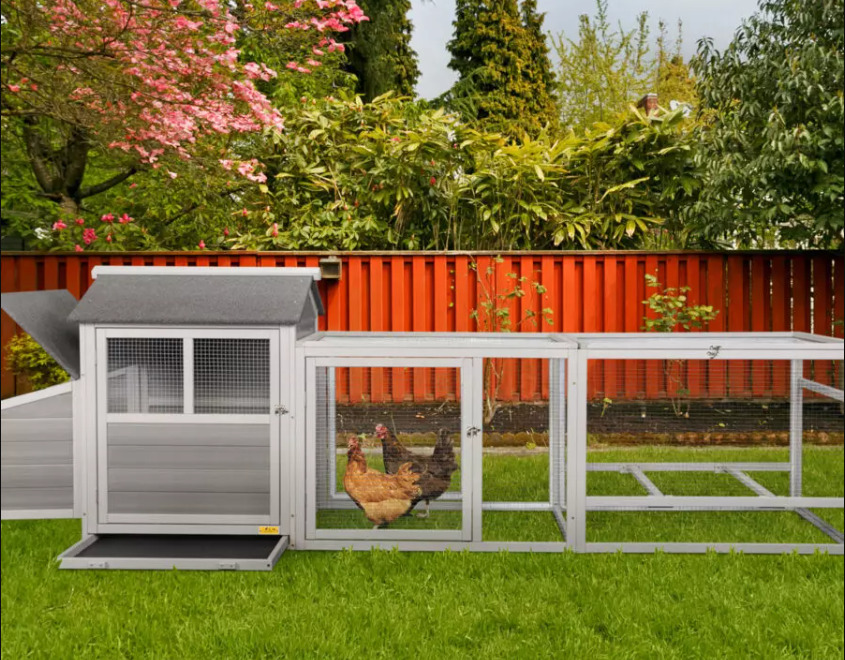Do you know the benefits and drawbacks of hens raised without confinement? Free-range hens are already a common trend, both on farms and in private homes. People want free-range chicken that has been farmed sustainably at the moment, and the market for it is very large. Indeed, there are certain benefits and drawbacks to raising free-range hens sustainably, which we will talk about below.
What is Free Range Chicken
Free range refers to an animal’s ability to roam freely outdoors without being restricted. Chickens that are allowed to roam freely are those that are not confined to a coop. This is the definition of free-range chicken. Chicken farming that uses free-range animals is sustainable, ecological, and kind to the environment. Additionally, this fits with the popularity of slow food.
The natural green food, insects, earthworms, and other animal feed sources found in orchards, woodlands, grassy slopes, and barren hills are utilized by free-range chickens. Additionally, seclusion offers favorable health conditions, a high likelihood of survival, and low investment. Utilizing the strengths of strong, active foraging chickens to harvest some of the necessary green feed and protein feed from the environment.
Pros of Free Range Chicken Farming
Let’s first examine the benefits of free-range hens before learning about their drawbacks.
Reduce Feed and Water Consumption
The primary sources of food for free-range hens are grass and insects, with extra feed being provided in the morning and evening. Chickens raised without access to a range require extremely little nutrition. With plastic nets placed centrally around the chicken house, you can split the available free-range chicken farm into a number of zones. You can have enough grass in this way to raise chickens without confinement. Rotational grazing can be practiced using this technique.
With an adequate supply of grass, organic free-range chickens only require a third to a quarter of what caged chickens consume in food, and because the insects and grass they eat contain some water, they only require a fifth to a third of what caged chickens drink. They also don’t require additional vitamins, minerals, or trace elements.
Save Labor and Material
Infrastructure for the flock is not required for free-range chickens. A large expense is a chicken coop. Simply lay out a light on a piece of plastic wrap and wire it to the free-range chicken farm. Free-range chicken reduces costs by roughly 66% compared to conventional chicken production, according to study.
Healthier, Happier for Range Free Chickens
A happier and healthier flock will result from letting hens range freely. Long-term confinement of chickens in a small area can lead to sickness. The chickens are not allowed enough room to move around because the area is too small. Unhealthy and unhappy flocks of hens can result from overcrowding.
On the other hand, giving chickens room to move about will give them a fun place to play. The chickens will feel better as a result of this. Therefore, free-range chicken will improve in health and happiness.
Enhance Stress Resistance
In the course of their daily feeding, drinking, playing, and fighting, free-range hens become acclimated to the sounds of wind, rain, thunder, lightning, and heat. And free-range organic chickens raised in the open air to gain a more complete and balanced diet and a fully calcified body. They can so adjust to sound, light, heat, and cold stimuli better. Therefore, free-range chicken has a high level of stress tolerance.
Reduces Disease and Death Rates and Drug Consumption
Free-range chickens thrive in a stunning natural setting. The feed source is plentiful, the air is clean, and the nourishment is complete. The body of a chicken raised in the wild is fully developed and immune to stress and sickness. Almost no antibiotics are required throughout the free range period, with the exception of the requirement to supplement with certain antibiotics to avoid infectious bronchitis during the closed brooding period. It is only required to incorporate some Chinese herbs into the feed if common ailments do occasionally arise as a result of abrupt weather changes.
Free-range organic hens rarely utilize medications to sanitize; instead, they rely on nature’s wind, sunlight, and heat to naturally purify and disinfect. As a result, free range organic chickens have few epidemics and little drug use.
Improve Meat and Egg Quality
The free-range chickens get a complete and balanced diet thanks to their lovely and fresh habitat and rich and diverse feed sources. They are heavily muscled and have a reasonable amount of fat. Eggs from free-range chickens are delicious and have a high nutritional value. Free-range chicken and eggs typically cost more than 4 RMB/kg more than cage-raised poultry and eggs.
Ecologically raised chickens consume insects, which are all sources of animal proteins from a nutritional standpoint. As a result, organic free range chickens are larger, have thicker feathers, more disease resistance, lay more eggs, produce tastier meat, and grow quickly.
Reduce the Cleaning of Chicken Coop
A seemingly simple task is actually highly challenging. Who has time to spend hours cleaning a sizable chicken coop? How frequently one should clean the coop is a common question. There is no definitive solution to this. It depends on how many chickens you have, how big your coop is, and how long the chickens stay inside.
However, if your farm raises free-range chickens, you won’t need to think about these issues. You don’t even need to clean the coop because free-range chickens use it very infrequently.
Cons of Free Range Chicken Farming
Does organic chicken taste better, then? Do not rush to respond because we will discuss the drawbacks of free-range chicken in the section that follows.
It Is Not Conducive to Epidemic Prevention
Chickens cannot be inoculated one by one like chickens in cages because of the roughness of free range. Likewise, water vaccination cannot successfully break the water. Even some free-range farmers stop immunizing their drinking water, which contributes to the widespread infectious diseases. Parasitic diseases cannot be cured, and they can sometimes worsen.
Easily Poisoned
Although no pesticides are used on the free-range plots, nearby homeowners or farmers may use pesticides on their own land. Frequently, additional poisoning is brought on by poisoned insects choosing nearby free-range hens before they pass away. Therefore, consuming poisoned insects by accident can easily make range-free chicken sick.
Vulnerable to Predators
Since free-range hens are more independent, predators have better access to them. This risk cannot be managed. Aerial hawks prey on both natural and artificial targets, including free-range organic chicken. These are issues that we frequently run against.
Damage to Yards
Additionally, a small free-range organic chicken can seriously harm a yard. They can move about a lot, and you can’t immediately stop them. In general, free range organic chickens can provide you issues like: In general, free range organic hens can be an issue for you because they may:
- Digging holes in your garden.
- Destroying your tools.
- Defecating and urinating on the ground.
- Destroying a beautiful and orderly garden.
Despite the fact that we adore the way free-range hens live, we don’t like the mess they can sometimes create. Therefore, this is a topic of concern, regardless of how large the organic free range chicken’s area of operation is.
Can’t Find Eggs
We only need to check the nest box for eggs when the hens are in cages. But when the chicken has been given free range, it is challenging to determine where the fowl has placed her eggs. Additionally, hens have the freedom to step on free-range eggs at will. You now have access to a very unpleasant component of the egg search.
Best Chicken Coop for Free Range Chickens

There is no question that the free range chicken coop needs to be big enough for chickens without a range. However, it shouldn’t be easy. Because a straightforward free-range chicken coop is very vulnerable during a storm. The ideal chicken house should be big enough and durable enough to endure the elements. Additionally, there ought to be sufficient amenities.
Free Range Chicken vs. Caged
There are several methods to tell free-range chickens from caged hens. So what makes the two different from one another? Come and learn with me.
- Body Weight
Over the same breeding season, free-range chickens weigh less than caged chickens. The reason for this is the increased body fat brought on by the restricted range of motion in captivity.
- Feed
The organic free-range hens can forage for pasture, insects, maize, rice, and wheat in a natural setting. To meet their specific species’ needs for energy, growth, and productivity, caged chickens are fed unique diets.
- Feeding Cycle
In general, free-range hens should be slaughtered after 120 days or longer. For the finest quality, allow 180–720 days before slaughter. The typical slaughter cycle for broiler chickens raised in cages is 45 days.
- Environment
As the name implies, free range organic chickens spend the most of their time outside, typically in woods, grassland, or other natural settings. Chickens raised outside can develop spontaneously and in a healthy environment! Because of this, free-range hens are also very healthy and resistant to disease.
Broiler cage living situations are simpler to picture! Low levels of exercise, polluted air, weak illness resistance, and a need for extensive vaccination and medicine are all factors that affect their survival rate. You can imagine the chickens’ health!
- Feathers
Organic free range hens have attractive, compact, lustrous, and well-groomed feathers. Chickens kept in cages have feathers that are generally poor and messy. The phenomena of beak hair frequently coexists with the density of raising, which is the cause of this.
- Movement
Chickens raised outdoors have a great capacity for flight and are energetic. They can move, play, fly high, and climb onto a shelf absolutely freely. Contrarily, chickens in cages lack space and essentially lose the use of their lower limbs. The distinguishing trait is that confined chickens are extremely adept at catching while free-range chickens are difficult to catch.
- Meat Quality
Range-free chicken has a lean muscular mass, little fat, a good flavor, and is nutrient-rich. Additionally, it contains a lot of protein, little fat, and no medication residue. The elderly, kids, pregnant women, and health-conscious people can all benefit from it. For caged chickens, the converse is true since they consume a lot of concentrate feed, get little movement, lay huge eggs, and have a high water ratio. Caged hens are employed in the catering business and are ideal for a variety of consumers.
Is Free Range Chicken Better?
There are no absolutes. In our essay, we discussed the benefits and drawbacks of free-range hens. additionally contrasted free-range hens with caged chickens. I believe you are aware of the solution.
Conclusion
True back-to-nature chicken farming is done with free range hens. It not only offers a lovely, clean natural setting, but also perfectly exemplifies the hens’ innate instincts. Free-range chickens are truly green because they don’t need antibiotics or chemical additives. The quality of free-range chicken eggs and meat is unmatched in today’s culture, where people’s living standards are rising. The drawbacks of chicken raised without cages should not be disregarded, though.


